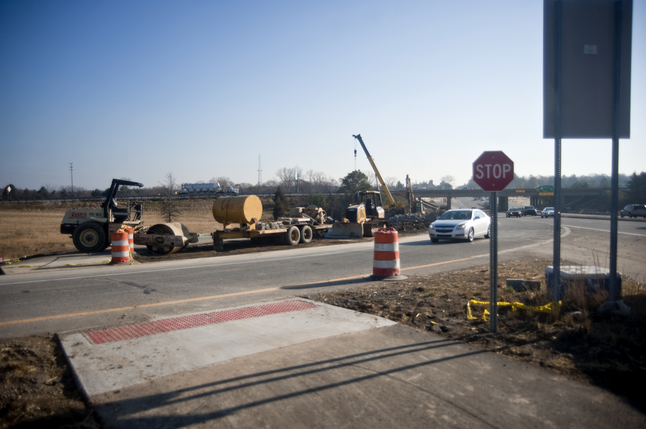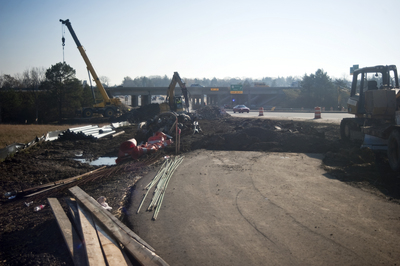Clik here to view.

The Michigan Department of Transportation is constructing a multi-use path along the south and north sides of Washtenaw Avenue at the U.S. 23 interchange at the eastern border of Ann Arbor. The path is a part of a ReImagine Washtenaw initiative intended to make the corridor more accommodating to multiple modes of transit.
Joseph Tobianski | AnnArbor.com
The Michigan Department of Transportation, which owns Washtenaw Avenue, is conducting a $2.27 million project to install a multi-use path from Carpenter Avenue to Yost Boulevard on both sides of Washtenaw that will allow pedestrians and bicyclists to safely travel underneath the U.S. 23 overpass.
The pathway also will cross the on- and off-ramps to and from U.S. 23. Additional improvements at intersections are also planned.
The walkway underneath U.S. 23 is a project that the city of Ann Arbor and Pittsfield Township have been requesting of MDOT for years.
Though construction crews will be clearing from the site by mid-December, work will resume there after the winter is over, said Kari Martin, planner for the MDOT region that includes Washtenaw County.
Clik here to view.

The northwest corner of the Washtenaw Avenue-U.S. 23 interchange, where MDOT is building a new multi-use paved path underneath U.S. 23.
Joseph Tobianski | AnnArbor.com
With the use of $250,000 from a $2.6 million grant from the U.S. Department of Housing and Urban Development to Washtenaw County’s Office of Community and Economic Development, a right-of-way study will be conducted on the 4.5-mile-long corridor to determine the optimal configuration to accommodate bike lanes, buses and pedestrians.
An additional $250,000 of the grant will be used to hire consultants to oversee the re-drafting of the city of Ypsilanti’s master plan, and changes to the master plans of Pittsfield and Ypsilanti townships.
Nathan Voght, project manager for ReImagine Washtenaw and an OCED economic development specialist, will be overseeing the administration of the grant money and has been working on the ReImagine Washtenaw initiative since February.
The master plans will be changed to reflect a set of design standards that Voght said are necessary to ensure that future development and road improvements along the Washtenaw Avenue corridor fit the vision of the four municipalities. Because Ann Arbor has a more progressive master plan in place, Voght said the city does not need to make any changes at this point.
The design standards have yet to be set in stone, but Voght said they will include specifications for sidewalk width, the location of trees and plantings as well as the placing of new buildings on a parcel of property.
One of the goals of ReImagine Washtenaw is to eliminate the large parking lots that often front the streetscape and make it intimidating for pedestrians to interact with the businesses themselves, Voght said. Bringing the building to front the street and putting parking in the rear will help in the placemaking process, Voght said.
There are about 10 miles of sidewalk in the Washtenaw Avenue corridor on both sides of the street, Voght said. However, there are 4 miles with no sidewalk at all.
The gaps have had numerous consequences, including creating a need for multiple bus stops.
AATA has had to build more bus stops along Washtenaw Avenue than it wanted to build because of the sidewalk gaps, Voght said.
Once the walkways are connected, AATA will be able to consolidate the stops into what Voght calls “super stops” that will be covered and include other amenities. The super stops could also reduce the number of times buses would interfere with the flow of traffic on the road, Voght said.
View ReImagine Washtenaw construction in a larger map
Amy Biolchini covers Washtenaw County, health and environmental issues for AnnArbor.com. Reach her at (734) 623-2552, amybiolchini@annarbor.com or on Twitter.